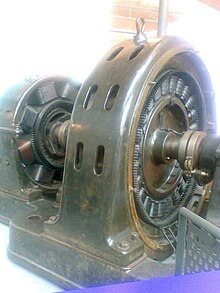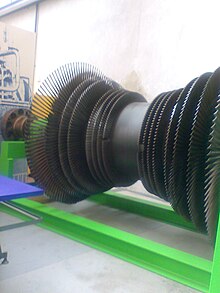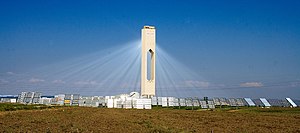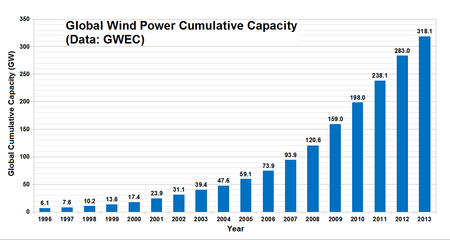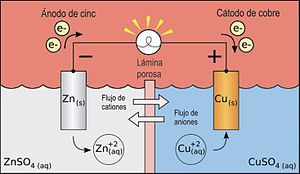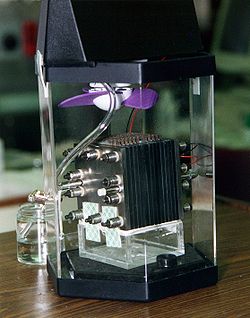Electric power generation
In general, the electric power generation consists of transforming some kind of energy (chemical, kinetic, thermal, light, nuclear, solar, among others), into electrical energy. For industrial generation, facilities called power plants are used, which carry out some of the aforementioned transformations. These constitute the first python of the electrical supply system an electrical generator; Although these do not differ from each other in terms of their operating principle, they vary depending on the way in which they are operated.
Since alternating current and the way to produce it in alternators were discovered, an immense technological activity has been carried out to bring electrical energy to all inhabited places in the world, therefore, together with the construction of large and varied power plants, sophisticated transmission networks and distribution systems have been built. However, the use has been and continues to be very uneven across the planet. Thus, industrialized or first world countries are large consumers of electrical energy, while developing countries barely enjoy its advantages.
The demand for electricity in a city, region or country varies throughout the day. This variation is a function of many factors, among which stand out: types of industries existing in the area and shifts that they carry out in their production, extreme cold or hot weather, type of electrical appliances that are used most frequently, type of water heater that has been installed in the homes, the season of the year and the time of day in which the demand is considered. Electric power generation must follow the demand curve and, as the demanded power increases, the supplied power must increase. This entails having to start generation with additional units, located in the same plant or in plants reserved for these periods. In general, the generation systems are differentiated by the period of the cycle in which they are planned to be used; Nuclear and wind are considered base, fossil fuel thermoelectric from the valley, and hydroelectric mainly from peak (fossil fuels and hydroelectric can also be used as a base if necessary).
| Global generation of electricity according to its source in 2018 (total bore 26.7 PWh) |
|---|
| Coal (38%) Natural gas (23%) Hydroelectric power (16%) Nuclear (10%) Wind (5%) Oil (3%) Solar (2%) Biofuels (2%) Others (1%) |
Depending on the primary source of energy used, generating plants are classified as thermoelectric (coal, oil, gas, nuclear and solar thermoelectric), hydroelectric (taking advantage of river or sea currents: tidal), wind and photovoltaic solar. Most of the electrical energy generated worldwide comes from the first two types of plants reviewed. All these plants, except the photovoltaic ones, have in common the generating element, constituted by a current alternator, moved by means of a turbine that will be different depending on the type of primary energy used.
On the other hand, 64% of the executives of the main electricity companies consider that in the horizon of 2018 there will be clean, WN, accessible and renewable technologies of local generation, which will force the large corporations in the sector to make a change of mentality.
Thermal power plants
A thermal or thermoelectric plant is a place used for the generation of electrical energy from heat. This heat can be obtained both from combustion, from the nuclear fission of uranium or other nuclear fuel, from the sun or from the interior of the Earth. Plants that use fusion in the future will also be thermoelectric plants. The most common fuels are fossil fuels (oil, natural gas or coal), their derivatives (gasoline, diesel), biofuels, urban solid waste, methane generated in some wastewater treatment plants.
Thermoelectric plants consist of a boiler in which fuel is burned to generate heat that is transferred to tubes through which water circulates, which evaporates. The steam obtained, at high pressure and temperature, is then expanded in a steam turbine, whose movement drives an alternator that generates electricity. Then the steam is cooled in a condenser where cold water circulates through tubes from an open flow of a river or through a cooling tower.
Conventional and combined cycle plants
Classic or conventional cycle power plants are those that use the combustion of coal, oil (oil) or natural gas to generate electricity. They are considered the most economical plants, so their use is widespread in the economically advanced world and in the developing world, despite the fact that they are being criticized due to their high environmental impact.
In thermoelectric power plants called combined cycle, two thermodynamic cycles are used in the same system, one whose working fluid is a gas that enters into combustion or burning, and another whose working fluid is steam under pressure. In a combustion chamber, natural gas is burned and air is injected to accelerate the speed of the gases and drive the gas turbine. Since these gases are still at a high temperature (500 °C) after passing through the turbine, they are reused to generate steam that drives a steam turbine. Each of these turbines drives an alternator, just like in a typical thermoelectric plant. The steam is then cooled by means of an open water flow or cooling tower as in a common thermal power plant. In addition, cogeneration can be obtained in this type of plants, by alternating between generation by means of natural gas or coal. This type of plants is capable of producing energy beyond the limitation of one of the two inputs and can take a step towards the use of energy sources for different inputs.
Thermal power plants that use combustion release carbon dioxide (CO2) into the atmosphere, considered the main gas responsible for global warming. Also, depending on the fuel used, they can emit other pollutants such as sulfur oxides, nitrogen oxides, solid particles (dust) and variable amounts of solid waste.
Solar thermal power plants
A solar thermal power plant or thermosolar power plant is an industrial installation in which, from the heating of a fluid by means of solar radiation and its use in a conventional thermodynamic cycle, the necessary power is produced to move an alternator for the generation of electrical energy as in a classic thermal power station. In them it is necessary to concentrate solar radiation so that high temperatures can be reached, from 300 °C to 1000 °C, and thus obtain an acceptable performance in the thermodynamic cycle, which could not be obtained with lower temperatures. The capture and concentration of solar rays are done by means of mirrors with automatic orientation that point to a central tower where the fluid is heated, or with smaller mechanisms of parabolic geometry. The set of the reflective surface and its orientation device is called a heliostat. Its main environmental problem is the need for large extensions of territory that are no longer useful for other uses (agricultural, forestry, etc.).
Although water is generally used as the fluid in the thermodynamic cycle, supercritical carbon dioxide mixtures are currently under development that could provide higher performance.
Geothermal power plants
Geothermal energy is that energy that can be obtained by taking advantage of the heat inside the Earth. The term "geothermal" It comes from the Greek geo (Earth), and thermos (heat). This internal heat heats even the deepest layers of water: when rising, hot water or steam produce manifestations, such as geysers or hot springs, used for heating since Roman times. Today, advances in drilling and pumping methods allow geothermal energy to be exploited in many places around the world. To take advantage of this energy in large-scale power plants, it is necessary that very high temperatures occur at shallow depths.
Nuclear Power Plants
A power station or nuclear plant or atomic power plant is an industrial facility used to generate electricity from nuclear energy. It is characterized by the use of fissionable nuclear fuel that, through nuclear reactions, provides heat that is used, through a conventional thermodynamic cycle, to produce the movement of alternators that transform mechanical work into electrical energy. These plants consist of one or more reactors. Nuclear power plants generate radioactive waste of various kinds that require maximum security final disposal and can contaminate in accidental situations (see Chernobyl accident).
Hydroelectric power station
A hydroelectric power station is one that is used to generate electrical energy by harnessing the potential energy of the water stored in a dam located at a higher level than the power station. The water is carried through a discharge pipe to the plant's engine room, where electricity is produced in alternators by means of huge hydraulic turbines and the water returns to its natural course after the turbines have left. The two main characteristics of a hydroelectric plant, from the point of view of its electricity generation capacity are:
- The power, which is the function of the difference between the average level of the reservoir and the average level of the waters below the center, and the maximum turbinable flow, in addition to the characteristics of the turbine and the generator.
- The energy guaranteed in a given lapse, usually a year, which is based on the useful volume of the reservoir, the annual rainfall and the installed power.
The power of a hydroelectric plant can vary from a few MW to several GW. Up to 10 MW are considered mini power stations. The largest hydroelectric power plant in the world (the Three Gorges Dam) is located in China, with an installed capacity of 22,500 MW. The second is the Itaipu Dam (belonging to Brazil and Paraguay), with an installed capacity of 14,000 MW in 20 turbines of 700 MW each.
This form of energy sometimes has environmental problems as it requires the construction of large reservoirs in which to accumulate water, which is subtracted from other uses, even urban on some occasions; However, another alternative used, especially in mini-hydroelectric plants, are run-of-river mini-power plants, which consist of carrying out an intake work using gratings, gates and a sand removal structure, in which the necessary water flow is dammed. for the operation of the turbines, letting the remaining flow flow through the natural course of the river, thus minimally affecting the environment.
Tidal power stations
Tidal power stations use the ebb and flow of the tides. In general, they can be useful in coastal areas where the tidal amplitude is high and the morphological conditions of the coast allow the construction of a dam that cuts off the entry and exit of the tide in a bay. Power is generated both at the time of filling and at the time of emptying the bay.
Currently, the commercial exploitation of the conversion into electricity of the energy potential of the sea waves is under development, in the so-called wave power plants.
Wind power plants
Wind energy is obtained through the movement of air, that is, from the kinetic energy generated by the effect of air currents or the vibrations that said wind produces. Windmills have been used for many centuries to grind grain, pump water, or other tasks that require energy. Currently, wind turbines are used to generate electricity, especially in areas exposed to frequent winds, such as coastal areas, mountainous heights or islands. Wind energy is related to the movement of air masses that move from areas of high atmospheric pressure to adjacent areas of low pressure, with speeds proportional to the pressure gradient.
The environmental impact of this system of obtaining energy is relatively low, being able to name the aesthetic impact, because they deform the landscape, the death of birds by colliding with the blades of the mills or the need for large extensions of territory to be subtract from other uses. In addition, this type of energy, like solar or hydroelectric, is strongly conditioned by weather conditions, their availability being random.
Photovoltaic power plants
Photovoltaic solar energy is the name given to obtaining electrical energy through photovoltaic panels. Photovoltaic panels, modules or collectors are made up of diode-type semiconductor devices that, when receiving solar radiation, are excited and cause electronic jumps, generating a small potential difference at their ends. The series coupling of several of these photodiodes allows obtaining higher voltages in very simple configurations and suitable for powering small electronic devices. On a larger scale, the direct electrical current provided by photovoltaic panels can be transformed into alternating current and injected into the electrical grid.
The implementation of photovoltaic solar energy has advanced considerably in recent years. The production of photovoltaic cells has been experiencing exponential growth, doubling every two years. Germany is, along with Japan, China and the United States, one of the countries where photovoltaics is experiencing the fastest growth. By the end of 2013, nearly 140 GW of PV power had been installed worldwide, making PV the third largest renewable energy source in terms of global installed capacity, after hydropower and wind power.. In some regions, the actual cost of photovoltaic production is already equivalent to the price of electricity from conventional energy sources, known as grid parity.
The main problems of this type of energy are the need for large extensions of territory that are subtracted from other uses and its dependence on weather conditions. This last problem makes energy storage systems necessary so that the power generated at a given moment can be used when its consumption is requested. There are energy storage systems such as kinetic storage, pumping water to high dams and chemical storage, among others.
Generation on a small scale
Generator set
A generator set is a machine that moves an electric power generator through an internal combustion engine. It is commonly used when there is a deficit in power generation somewhere, or when there is a power outage and it is necessary to maintain activity. One of its most common uses is in those places where there is no supply through the electrical network, generally they are agricultural areas with little infrastructure or isolated houses. Another case is in public places, hospitals, factories, etc., which, in the absence of mains electricity, need another source of alternate energy to be supplied in case of emergency. A generator set consists of the following parts:
- Internal combustion engine. The engine that triggers the generator is usually designed specifically to perform the work. Its power depends on the characteristics of the generator. They can be gasoline or diesel engines.
- Refrigeration system. The engine cooling system is problematic, because it is a static engine, and can be refrigerated by means of water, oil or air.
- Alternator. The output electric power is produced by means of a screened alternator, protected against splashes, self-excited, self-regulated and without scobillas, coupled with precision to the engine. The size of the alternator and its performances are very variable depending on the amount of energy they have to generate.
- Fuel and banking tank. The engine and alternator are coupled and mounted on a steel bench. Banking includes a fuel tank with a minimum operating capacity at full load according to the technical specifications that the group has in its autonomy.
- Control system. You can install one of the different types of panels and control systems that exist to control the operation, output of the group and protection against possible malfunctions.
- Automatic output switch. To protect the alternator, they have installed an automatic output switch suitable for the model and output regime of the generator. There are other devices that help control and maintain, automatically, the correct operation of the same.
- Engine regulation. The engine regulator is a mechanical device designed to maintain constant engine speed relative to load requirements. The engine speed is directly related to the alternator output frequency, so any engine speed variation will affect the output power frequency.
Voltaic battery
A device that generates electrical energy by a transitory chemical process is commonly called an electric battery, after which its activity ceases and its constituent elements have to be renewed, since their characteristics are altered during it. It's about a primary generator. This energy is accessible through two terminals that the battery has, called poles, electrodes or terminals. One of them is the negative pole or cathode and the other is the positive pole or anode. In Spanish it is customary to call it that, while rechargeable batteries or accumulators have been called battery.
The first electric battery was made known to the world by Volta in 1800, through a letter he sent to the president of the London Royal Society, therefore they are elements from the early days of electricity. Although the appearance of a battery is simple, the explanation of its operation is far from it and motivated great scientific activity in the 19th and 20th centuries, as well as various theories, and the growing demand for this product in the market continues to make it subject of intense investigation.
The operation of a battery is based on the contact potential between two substances, mediated by an electrolyte. When a greater current is needed than the one that can be supplied by a single element, with its voltage being adequate, one can add other elements in the connection called in parallel. The total capacity of a battery is measured in amp-hours (A•h); is the maximum number of amps that the element can supply in one hour. It is a value that is not usually known, since it is not very clear since it depends on the intensity requested and the temperature.
An important advance in the quality of batteries has been the so-called dry battery, to which practically all those used today belong. Electric cells, batteries and accumulators come in a few standard forms depending on their shape, voltage and capacity.
The metals and chemical products that make up batteries can be harmful to the environment, producing chemical pollution. It is very important not to throw them away (in some countries it is not allowed), but take them to recycling centers. In some countries, most dealers and specialist shops also take charge of used batteries. Once the metal casing that covers the batteries is damaged, the chemicals they contain are released into the environment causing pollution. To a greater or lesser degree, the substances are absorbed by the earth, being able to filter into the aquifers and from these they can pass directly to living beings, thus entering the food chain. Batteries are hazardous waste, so from the moment they begin to be collected, they must be handled by trained personnel who follow the appropriate precautions using all technical and legal procedures for handling said waste.
These batteries are usually used in portable electrical devices, which are a large number of devices that have been invented and that are powered by the energy provided by one or more electric batteries or rechargeable batteries. Mass-use devices include toys, flashlights, watches, mobile phones, pacemakers, hearing aids, calculators, portable personal computers, music players, transistor radios, remote controls, etc.
Fuel Cells
A cell, cell or fuel cell is an electrochemical device for generating electricity similar to a battery, which differs from it in that it is designed to allow continuous replenishment of consumed reagents. This allows electricity to be produced from an external source of fuel and oxygen, as opposed to the limited energy storage capacity of a battery. In addition, the chemical composition of the electrodes of a battery changes according to the state of charge, while in a fuel cell the electrodes work by the action of catalysts, so they are much more stable.
In hydrogen cells the reagents used are hydrogen at the anode and oxygen at the cathode. A continuous supply of hydrogen can be obtained from the electrolysis of water, which requires a primary source of electricity generation, or from catalytic reactions that evolve hydrogen from hydrocarbons. Hydrogen can be stored, which would allow the use of non-continuous sources of energy such as solar and wind. Gaseous hydrogen (H2) is highly flammable and explosive, so storage methods in porous matrices of various materials are being developed.
Radioisotope Thermoelectric Generator
A radioisotope thermoelectric generator is a simple electrical generator that obtains its energy released by the radioactive decay of certain elements. In this device, the heat released by the decay of a radioactive material is converted into electricity directly thanks to the use of a series of thermocouples, which convert the heat into electricity thanks to the Seebeck effect in the so-called Radioisotope Heat Unit (or RHU in English).
RTGs can be considered a type of battery and have been used in satellites, unmanned space probes, and remote installations that have no other type of electrical or heat source.
RTGs are the most suitable devices in situations where there is no human presence and powers of several hundred watts are needed for long periods of time, situations in which conventional generators such as fuel cells or batteries are not viable economically and where photovoltaic cells cannot be used.
Contenido relacionado
Corvette
Secure Shell
Mechanics
